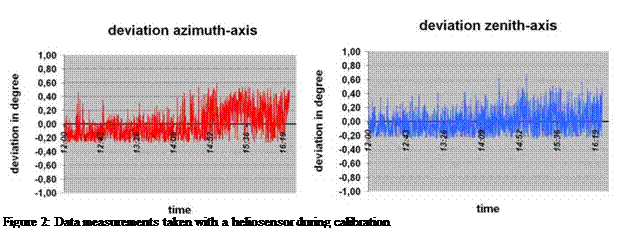Two-Axis Tracker
PSE has been developing uniaxial and biaxial trackers for several years, for use in linear concentrating Fresnel collectors [2], heliostats, measurement of solar thermal collectors, etc. The mechanical design of this testing tracker is especially rugged; it has a maximum load allowance of 700 kg on the 5 x 2.5 m test surface. The guaranteed tracking precision is ±1°; however, the average precision during normal operations is much better. The tracking precision was verified using a “Heliosensor” [3], PSE’s sun position sensor.
 |
The heliosensor is used to calibrate both the rotary encoder, which records the azimuth angle, and the inclination sensor, which records the zenith angle, during installation. After the sensors have been calibrated, the orientation of the testing surface is updated using an astronomical algorithm.
So as not to compromise the tracker’s precision, the track-laying and mounting of the two-axis tracker onto the moveable carriage must be carried out with especially high precision.
The tracker has three different operating modes: manual, automatic tracking, and user-defined tracking.
|
Figure 3: Left: Two-axis tracker with a testing surface of 5 m x 2.5 m; Right: Screenshot of the corresponding software. |
The tracker is operated using software installed on a local network PC, which communicates with the tracker’s controls, an embedded Linux system, via the network connection.
The testing surface is completed with four cross-flow fans, which ensure that the collector is ventilated according to current norms during measurements.
